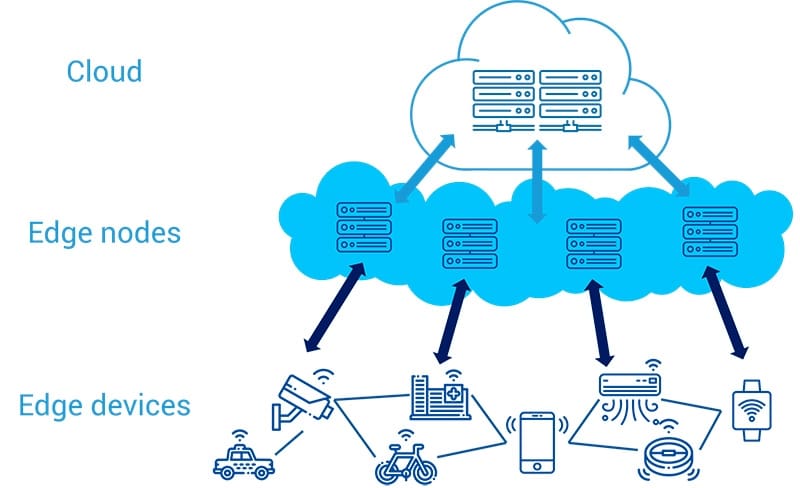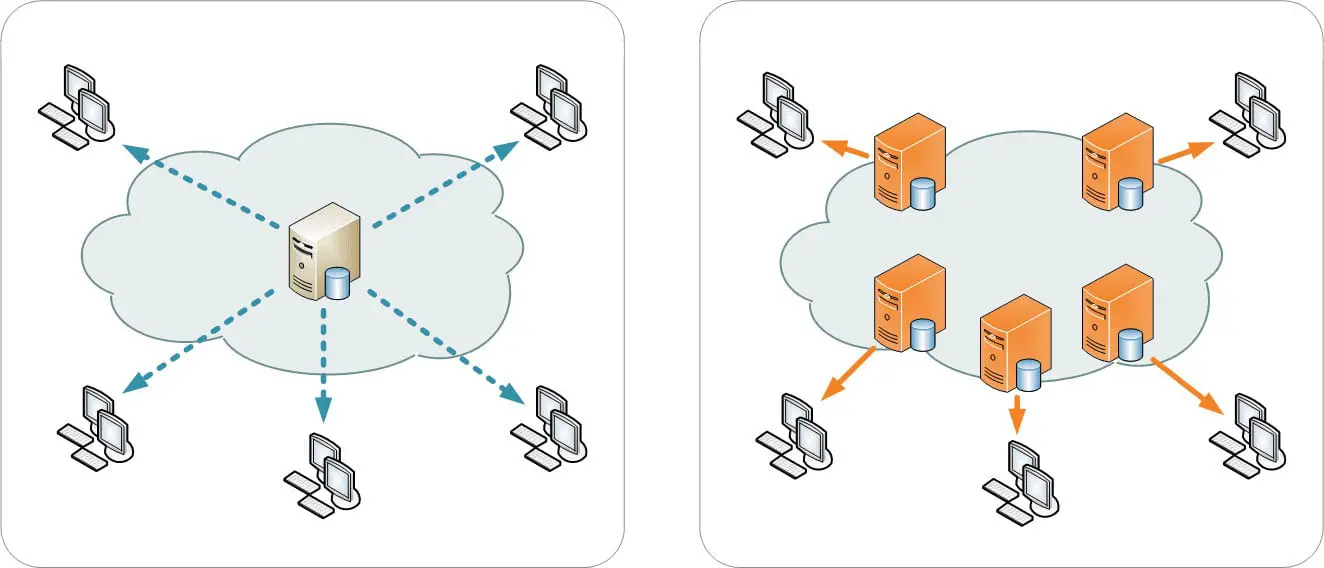Edge computing is a computing paradigm that brings data storage, and CDN is a group of servers that work together for high security and network.
And edge computing is improved by the CDN networks and the websites, while the CDN network doesn’t. CDN is focused on transmitting cached data
Key Takeaways
- Edge computing involves processing data near the source, while CDN delivers content from servers closer to the user.
- Edge computing is used to reduce latency and improve response times, while a CDN improves the performance of websites and web applications.
- Edge computing is commonly used in Internet of Things (IoT) applications, while CDNs are used in e-commerce and media streaming applications.
Edge Computing vs CDN
Edge computing refers to processing data and running applications on devices located at or near the edge of the network rather than on centralized servers. CDN is a distributed server network that works together to deliver web content to users more quickly and efficiently. This reduces latency and speeds up content delivery.

Edge computing is a computing paradigm that brings data storage and other computation data which is present near the data sources, which have significant variability in the design for the companies
which need the computing challenges. Another use of this is cloud gaming.
CDN is a Content delivery network(CDN). This refers to the geographically distributed group of server which works together, which has less variability in the design and makes things easier.
The CDN is built in a unique way that increases its connection or network.
Comparison Table
| Parameters of Comparison | Edge computing | CDN |
|---|---|---|
| Server location | It is placed closer to the user but is not limited to conventional servers. | It caches the content an origin server provides and is not meant to replace the host server. |
| Server function | It takes many forms and servers that perform calculations and run applications independently. | It has significant variability in the design for the companies that need the computing challenges. |
| Server design | Supports many other types of computing, like live streaming, gaming, and AI. | Have less variability in the design and make things easier |
| Transmission | Any network does not improve it. | Focus on transmitting cached data |
| Improvement | CDN network improves the edge computing | It is not improved by any network. |
What is Edge computing?
Edge computing is a computing paradigm that brings data storage and other computation data that is present near the data sources. This improves the timing and saves bandwidth.
Misconception and loT are synonymous. And this term refers to architecture rather than technology.
This was introduced in the year 1990 so that it could serve the video and web content from the edge server.
In the 2000s, these networks host the application and the components,, which sever the edges: dealer locators, shopping carts, and real-time data.
The application of this server is to reduce the volume of the data that should be moved and the transmission costs. Another use of this is cloud gaming.
Edge computing may also be defined as software sending low-probability requests to the relative frequency. All those broadly happen outside the cloud at the edge of the network.
According to the edge state of the network, it serves the last mile network proximately. Edge notes are used for gaming streaming and are known as the game lets.
It has the concept of privacy, security, scalability, reliability, speed, and efficiency.

What is CDN?
The CDN (Content Delivery Network) is a geographically spread set of servers that work together to offer fast internet connections and delivery.
CDN enables the rapid delivery of materials such as HTML, pages, javascript files, stylesheets, photos, and videos required to load the internet.
It also helps protect the website against some common attacks, known as distributed denial of service (DDOS) attacks.
And there are so many benefits of CDN that are present that are called improving the website load times, reducing the bandwidth cost, increasing the content availability and redundancy, and improving the website security.
This aims to deliver the content quickly with more security and provide the capability, reliability, and all the possible sequence.
IXPs are used here to locate the difference in the internet connection to the different providers so that everyone has access to the traffic-originated networks.
High data security present as it keeps the site secure and contains TLS/SSL certificate, which has high standers for authorization and integrity, and the security level sounds the CDNs and explores the content delivery.
The CDN is built in such a way that it increases connection.

Main Differences Between Edge Computing and CDN
- Edge computing server location is placed closer to the user. Still, it is not limited to conventional servers, whereas CDN server location is placed to the conventional server near to the delivered content to specific regions.
- Edge computing server function takes many forms and servers that perform calculations and run applications independently. In contrast, the CDN server function caches the content an origin server provides and is not meant to replace the host server.
- Edge computing server design has great variability in the design for the companies which need the computing challenges, whereas CDN server design Has less variability in the design and makes things easier.
- Edge computing supports many other types of computing, like live streaming, gaming, and AI, whereas CDN Focus on transmitting cached data.
- The CDN network improves edge computing, whereas any network does not improve CDN.

- https://www.hindawi.com/journals/scn/2021/8846239/
- https://link.springer.com/article/10.1186/s13638-019-1590-2

The content is informative, but doesn’t delve deeply into the drawbacks and limitations of these technologies, which is essential for a comprehensive understanding
I second this. The article is to compare the two technologies, not to detail the negative aspects.
I actually disagree with you. The article is not supposed to point out the negative aspects, rather only the comparisons. That’s why we need to have a broader understanding by seeking additional sources of information.
Text approves edge computing and its advantages where CDN is referred to as a secondary factor. Text is informative and helpful. It clearly states which is better.
CDN delievers content faster and is more focused on performance of websites which is more benefical than edge computing.
Edge computing and CDN are both necessary and have their own unique advantages, this article is quite helpful in providing detailed information on each.
Edge computing and CDN both have difference use cases, its not about which one is better but more about which one is more appropriate based on specific application needs.
It is evident that edge computing offers more than a CDN. The data transmitted by CDN network is usually caches, where edge computing is able to process data near the source reducing latency.